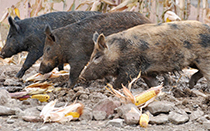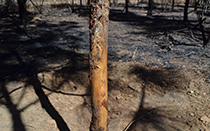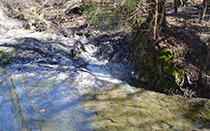Damage by Wild Pigs
 The majority of the damaged caused by wild pigs is
a direct result of their feeding behavior. With their tough snouts and over
developed neck muscles wild pigs become nature’s “bull dozers,” motivated by
the pursuit of grub worms and roots of herbaceous plants. In their seemingly
never ending pursuit of food wild pigs cause damage to agricultural crops, livestock, forests, and the environment.
The majority of the damaged caused by wild pigs is
a direct result of their feeding behavior. With their tough snouts and over
developed neck muscles wild pigs become nature’s “bull dozers,” motivated by
the pursuit of grub worms and roots of herbaceous plants. In their seemingly
never ending pursuit of food wild pigs cause damage to agricultural crops, livestock, forests, and the environment.
Agricultural Damage
The agricultural damage caused by wild pigs costs farmers in the United States millions of dollars every year. Hogs cause damage either by eating or trampling agriculture crops. Damage is also occurs through rooting and wallowing. These activities not only cause direct damage to crops but the holes and ruts created in ag fields can lead to damage to farm equipment and endanger equipment operators. Rooting also damages turf and irrigation equipment.
Damage to Livestock
Wild pigs threaten livestock in three ways.The first is through predation. Pigs are opportunistic omnivores and will readily feed on newborn sheep, goats, and calves. Wild hogs also affect livestock through the spread of disease. There are a number of diseases carried by wild pigs that can be contracted by domestic livestock including brucellosis, pseudorabies,and classical swine fever. More info can be found here. Another way wild pigs threaten livestock is through competition. If wild pigs gain access to a livestock feeding lot they will readily consume food and exclude livestock from feeding.
Forest Damage
 The presence of wild pigs in a hardwood forest can
inhibit and even stop forest regeneration. Hard mast such as acorns, hickory
nuts, and beach nuts are seasonally important food sources for wild pigs, and they leave very few to germinate and grow into future mast bearing trees. Any mast
that does germinate and begins growth is often consumed by hogs shortly
thereafter. In pine plantations hogs will root up pine
seedlings and consume the roots. This sort of damage can cost timber companies
and private plantation owners millions of dollars in future timber sales.
The presence of wild pigs in a hardwood forest can
inhibit and even stop forest regeneration. Hard mast such as acorns, hickory
nuts, and beach nuts are seasonally important food sources for wild pigs, and they leave very few to germinate and grow into future mast bearing trees. Any mast
that does germinate and begins growth is often consumed by hogs shortly
thereafter. In pine plantations hogs will root up pine
seedlings and consume the roots. This sort of damage can cost timber companies
and private plantation owners millions of dollars in future timber sales.
Other damage caused by wild pigs in forests is caused by scent marking. Boars often use hardwood and pine saplings to mark territory. Damage is done through tusking and rubbing; both of these activities removes the bark from trees, exposing them to harmful insects and pathogens. The presence of wild pigs in a forested system can also lead to a decrease in animal diversity. This is due in part to the competition for resources and the reduction in available habitat.
Damage to Native Species
Wild pigs may damage native species in three ways: competition, predation, and destruction of habitat.
Competition
Wild pigs out compete most species, especially deer and turkey, for food and space. Competition is especially high whenever soft (grapes, berries, & other fruits) and hard mast (acorns, hickory nuts, and beach nuts) become available. However, competition also occurs between wild pigs and mesopredators like bobcats, raccoons, and opossums.
Predation
Though not considered aggressive predators, wild pigs do consume a variety of wildlife species. These animals will readily feed on the eggs of ground nesting birds and sea turtles. They will also consume small mammals, snakes, salamanders, and frogs. While they are not a significant predator of whitetail deer wild hogs will also depredate fawns, especially newborns.
Destruction of Habitat
Most of the behavior displayed by a feral hog is prone to cause some form of damage. Rooting, wallowing, tusking, and rubbing often destroys native plant communities that provide both food and habitat for a variety of native wildlife. This destruction of habitat also creates environmental issues such as erosion, invasion of non-native vegetative species, and a decline in water quality.
Environmental Damage
Soil Disturbance
 Rooting and wallowing are the two main activities
that cause environmental damage. Rooting exposes bare soil that becomes prone to
erosion during rain events. Soil washes into streams causing siltation and degrading water quality and fish habitat.
Rooting and wallowing are the two main activities
that cause environmental damage. Rooting exposes bare soil that becomes prone to
erosion during rain events. Soil washes into streams causing siltation and degrading water quality and fish habitat.
In addition to stream siltation exposed soils invite colonization by invasive vegetative species that typically favor disturbed sites. Invasion of exotic plant species reduces biodiversity in the plant community and reduces food availability for many native wildlife species that depend on the native plant community.
Water Quality
Siltation caused by hog activity increases water turbidity (excessive silt and particle suspension) and bacterial contamination. Increases in turbidity prevents light from reaching the bottom of the water body and prevents aquatic vegetation from being able to photosynthesize, reducing the available dissolved oxygen in the water. Excessive siltation can also clog the gills of fish, freshwater mussels, amphibians, and insect larvae. Excessive turbidity and feces in a stream may increase fecal coliform concentrations above human health standards.
Additionally, feces from wild pigs in farm ponds can lead to fish kills. Excess nutrients from fecal coliform can cause an algal bloom that prevents sunlight from penetrating to the bottom of the pond. This causes phytoplankton and algae below the upper layer of algae to decompose, robbing the pond of available dissolved oxygen and hurting the survivability of fish and other aquatic organisms.


